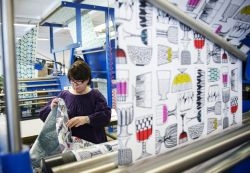Marimekko’s women take ’60s success into long bloom

With its bright floral and geometric prints, Marimekko is synonymous with modern Finnish design and the company that started in 1951 as a small family-run business now has more than 100 stores selling clothing, crockery and home decor in Tokyo, Paris, Hong Kong and Beverly Hills.
« Our goal is to make people happy with our products that are part of their daily lives. They can use one of our coloured mugs and wear a piece of clothing with the same pattern, » Marimekko spokeswoman Sanna-Kaisa Niikko says over the din of the textile machines rumbling behind her.
Large swathes of colourful material roll off the machines as members of the design and manufacturing teams bustle around, most of them women — not so strange given that a whopping 90 percent of the company’s 500 employees are women.
Since its foundation in 1951 by Armi Ratia, Marimekko has been all about putting women first.
In the 1960s, the brand made a splash by presenting itself as an alternative to post-war fashion, when women squeezed into uncomfortable girdles under body-conscious and sober outfits.
Their roomy, comfortable dresses with bold colours and clean lines were perfectly adapted to a new generation throwing off the strictures of the 1950s and embracing women’s liberation.
« At the time, it was very unique, » says Pekka Korvenmaa, a design professor at Helsinki’s Aalto University.
At the factory, many of the employees recall with pride how one particularly stylish customer catapulted the brand onto the international fashion scene.
« In 1960, Jackie Kennedy stood next to her husband wearing one of our dresses, » explains Niikko.
The then-First Lady of the United States, known for her sense of style, wore a sleeveless red number on the cover of Sports Illustrated, buying seven of the dresses for herself and elevating the brand to icon status as Marimekko hit the pages of Vogue, Elle and Harper’s Bazaar and went on sale in New York’s trendiest boutiques.
In 1964, Marimekko’s star designer Maija Isola created the Unikko print featuring over-sized poppies, which quickly became the brand’s most recognisable pattern and is still popular today.
That was followed in 1968 by a simple striped unisex tee, with the even stripes symbolising equality, also in line with the times.
The company did well through the 1970s, but by the mid-1980s it had fallen on hard times. Ratia had passed away, and Marimekko had been sold to Finnish industrial group Amer.
Poorly managed, it had lost its way artistically and teetered on the verge of bankruptcy until 1991 when retired Finnish advertising executive Kirsti Paakkanen bought the brand, determined to give it new life.
« Paakkanen knew the world of design and she knew how it worked. Marimekko lacked this kind of people, » explains Korvenmaa.
« She put the brand back on track by mixing innovation and the use of old patterns created in the 1960s, » he adds.
Marimekko quickly recovered its international cachet.
By the end of the 1990s, the hit American show « Sex and the City » featured Marimekko curtains in the apartment of main character and fashionista Carrie Bradshaw, and Sarah Jessica Parker, the actress who played Carrie, is a real-life fan of the brand too.
Other celebrity devotees include Elton John, who was pictured wearing Converse trainers with a Marimekko print in St Tropez, and former US secretary of state Hillary Clinton who last year took time out of her schedule during a visit to Helsinki to tour the Marimekko factory. She left toting overflowing shopping bags.
In 2008, Paakkanen sold the company to Mika Ihomuotila, a banker who took over as chief executive. He has since kept the Marimekko ship on the same course steered by Paakkanen.
At the factory, the textile machines every day roll out as many Unikko prints, soon 50 years old, as they do new innovative creations by the 40 or so in-house designers.
« We release four collections per year, one per season. The designers use nature and the weather as inspiration, because they are big topics of conversation in Finland, » laughs Pirkko Heikkilae, who heads the home decor design team.
All of the designs are « Made in Finland », and while many other retailers make their products in labour-cheap Asia, Marimekko had 79 percent of its manufacturing and production in Finland and other European Union countries last year.
Its 2012 sales hit a respectable 88.5 million euros ($115 million). For a company of such modest size, the brand’s reach and reputation is even more impressive.
But with heavy investments and loss-making stores in Sweden and the US last year, the company fell into the red in 2012. It nonetheless plans to open up to 24 new shops this year, a gamble amid the global economic crisis.
Disappointingly for those nostalgic of the brand’s 1960s-era success, Marimekko is no longer associated with the promotion of women’s issues.
According to professor Korvenmaa, the company has simply evolved with the times.
« It keeps one special feature, which makes it successful today, » he says. « Its a small brand, almost a family brand, which managed to be famous abroad, thanks to this mix of old and new patterns. »

